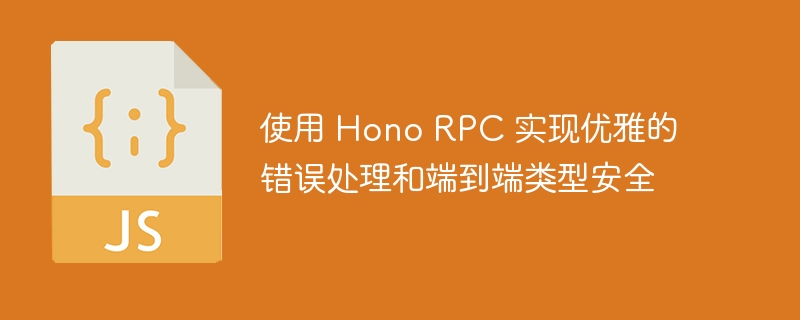使用 Hono RPC 实现优雅的错误处理和端到端类型安全
时间:2025-01-14 14:18:21 108浏览 收藏
最近发现不少小伙伴都对文章很感兴趣,所以今天继续给大家介绍文章相关的知识,本文《使用 Hono RPC 实现优雅的错误处理和端到端类型安全》主要内容涉及到等等知识点,希望能帮到你!当然如果阅读本文时存在不同想法,可以在评论中表达,但是请勿使用过激的措辞~

JavaScript 的错误处理机制,虽然提供了 try-catch 块和异常抛出,但在实际应用中常常显得不够简洁直观。 本文介绍一种借鉴 Golang 错误处理方式,结合 Hono RPC 实现更优雅、类型安全的错误处理方法。
传统 JavaScript 错误处理模式冗长且缺乏错误类型信息:
const onsubmit = async (data: signupschema) => {
const res = await callrpc(api.auth.signup.$post({ json: data }));
if (res.error) {
toast.error(res.error);
return;
}
toast.success("Account created successfully");
router.navigate({ to: "/" });
};
缺点
- 后端仅返回错误文本和成功响应 JSON。
- 偏离了 JavaScript 的传统错误处理方式。
- 需要立即处理错误,可能并非所有场景都适用。
理论要掌握,实操不能落!以上关于《使用 Hono RPC 实现优雅的错误处理和端到端类型安全》的详细介绍,大家都掌握了吧!如果想要继续提升自己的能力,那么就来关注golang学习网公众号吧!
相关阅读
更多>
-
502 收藏
-
501 收藏
-
501 收藏
-
501 收藏
-
501 收藏
最新阅读
更多>
-
225 收藏
-
250 收藏
-
446 收藏
-
228 收藏
-
360 收藏
-
165 收藏
-
320 收藏
-
362 收藏
-
344 收藏
-
120 收藏
-
456 收藏
-
146 收藏
课程推荐
更多>
-

- 前端进阶之JavaScript设计模式
- 设计模式是开发人员在软件开发过程中面临一般问题时的解决方案,代表了最佳的实践。本课程的主打内容包括JS常见设计模式以及具体应用场景,打造一站式知识长龙服务,适合有JS基础的同学学习。
- 立即学习 543次学习
-

- GO语言核心编程课程
- 本课程采用真实案例,全面具体可落地,从理论到实践,一步一步将GO核心编程技术、编程思想、底层实现融会贯通,使学习者贴近时代脉搏,做IT互联网时代的弄潮儿。
- 立即学习 516次学习
-

- 简单聊聊mysql8与网络通信
- 如有问题加微信:Le-studyg;在课程中,我们将首先介绍MySQL8的新特性,包括性能优化、安全增强、新数据类型等,帮助学生快速熟悉MySQL8的最新功能。接着,我们将深入解析MySQL的网络通信机制,包括协议、连接管理、数据传输等,让
- 立即学习 500次学习
-

- JavaScript正则表达式基础与实战
- 在任何一门编程语言中,正则表达式,都是一项重要的知识,它提供了高效的字符串匹配与捕获机制,可以极大的简化程序设计。
- 立即学习 487次学习
-

- 从零制作响应式网站—Grid布局
- 本系列教程将展示从零制作一个假想的网络科技公司官网,分为导航,轮播,关于我们,成功案例,服务流程,团队介绍,数据部分,公司动态,底部信息等内容区块。网站整体采用CSSGrid布局,支持响应式,有流畅过渡和展现动画。
- 立即学习 485次学习
